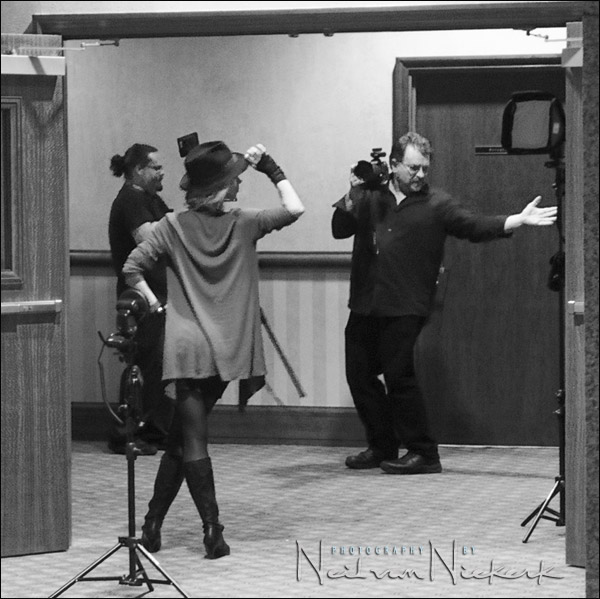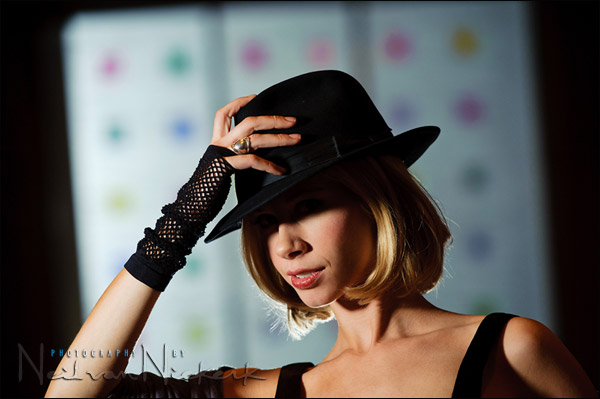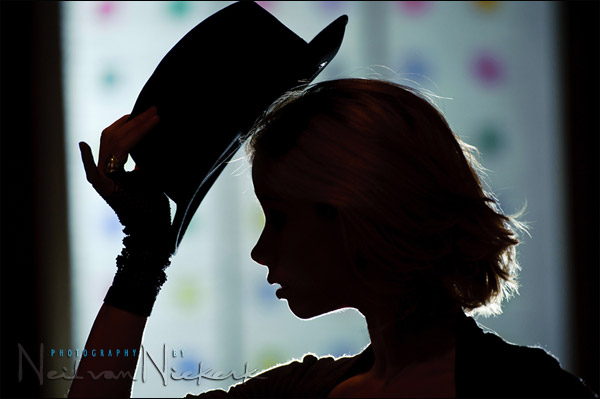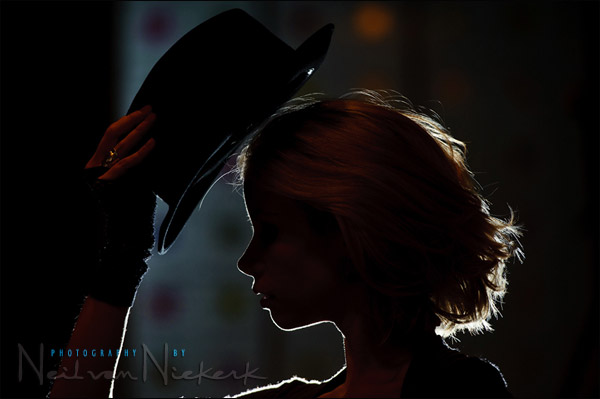
photo session – Shawna – using the PocketWizard AC3 Zone Controller
While in Las Vegas for WPPI 2011, the team at PocketWizard asked me if I would be interested in them shooting a short video clip of me using the new PocketWizards for Nikon. I didn’t hesitate in saying yes! Here is the description of the setup of the one photo sessions I did. There was another one, which I will post in a day or so. I will post a link to the PocketWizard video clip as soon as it is up.
For this demonstration of the PocketWizard FlexTT5 and AC3 ZoneController, I relied on Shawna, a favorite model, Shawna, again. (She featured in the recent posts on video light vs bounce flash and using the available light. I knew we’d be able to get some stunning images with such a stunning model and the new photo toys …
I used a FlexTT5 on my camera, with an AC3 piggy-backing on it, and three speedlights, each controlled via a FlexTT5 unit.
The lighting-set-up:
– main light to camera left: a speedlight in a Lastolite 8.6″ Ezybox (B&H)
– rim-light via a speedlight on a light-stand directly behind Shawna
– background light via a speedlight on a monopod, held up by an assistant.
Unfortunately, I forgot to take a pull-back shot, but the set-up is very similar to this one I had for the recent photo of Josh Adams in the convention room of a hotel:
The only difference is that in this photo session with Shawna, I had the background speedlight behind a large frosted glass pane. I had a friend hold that speedlight up behind the glass panel, but off to the side, so that the speedlight doesn’t create a singular hot-spot on the glass. So she had to hold the speedlight off to the side, off the camera’s axis, and out of the frame.
Not quite a pull-back shot, but here is a snap from someone helping me – it shows the position of the back-light, and my own position and the softbox. And my oh-so graceful way of posing a model.

The settings for the speedlights:
– group A: main light to camera left: a speedlight in the Lastolite 8.6″ Ezybox (B&H);
this was set to TTL initially, but I changed it to manual flash at some point during the shoot for a specific reason – the background light was affecting my TTL flash metering too much, and I was getting erratic exposure. At some point when you have to ride your TTL flash too much via FEC, it just becomes simpler to switch to Manual flash. It’s the point at which the speed of working with TTL isn’t speedy any more.
– group B: rim-light via a speedlight on a light-stand directly behind Shawna;
This was manual flash. It has to be manual, since the camera doesn’t really meter this light. It therefore doesn’t make sense really to have this set to TTL.
– group C: background light via a speedlight on a monopod, held up by an assistant.
Without properly thinking this through, I started off with this light set to TTL. But the way the TTL flash metering figured out the background exposure for this – a large splash of bright light – just made it too inconsistent. A simple flick of the control switch on the top of the PocketWizard AC3 Zone Controller, and I had changed the background light (group C) to Manual flash. I then dialed it down until I got the brightness for the background that I liked. It’s not really something you could meter for with a handheld meter, since the background is flash lighting up a frosted glass pane from behind. So this really is the forte of digital photography, and chimping the shot until you like it.
In the end, I had all three speedlights set to Manual. Simplicity, especially for a static set-up like this.
This sequence of images will show the beauty of using the PocketWizard AC3 Zone Controller to control the various speedlights.
From the image where I had the three lights going off, I could turn off the main light on Shawna by switching group A off. (The AC3 Zone Controller has a switch that can take any group to Manual or TTL or to an off position.
Now I just have the rim-light, and the speedlight lighting up the glass panel in the background. This is from the same sequence as the image at the start, but just a horizontal option.
By flicking the switch controlling the background light (set as group C), I can have a purely rim-lit silhouette.
… or I can bring back a little bit of detail by enabling the background light again, but dialling down the power on it.
In this way I can now change any of the three groups from my camera via the AC3 ZoneController, without delving into the menu of a Master speedlight. It’s a fast way of working, cutting out incessant menu options and button pushing.
A final image from this entire set. I really wanted Shawna’s eyes shrouded like that by the hat. A sense of mystery and an elegant pose.
Using the FlexTT5 on the camera instead of the MiniTT1
During this session I used the FlexTT5 on the camera and not the MiniTT1, and I suspect I am going to default to this setup for two reasons:
The MiniTT1 takes those CR2450 coin cell batteries. This would mean carrying specific spare batteries for it. The FlexTT5 takes two AA batteries. Everyone has those lying around and it shouldn’t be a problem to get your hands on two of those if the batteries in a FlexTT5 are running low.
Coin cell batteries are also more easily affected by cold temperatures. The spec sheet for the MiniTT1 says that it can work in the -12 Celcius to 50 Celcius range (10 Fahrenheit to 120 Fahrenheit). With the photo session of Keegan, we also went to Times Square with Keegan, and I ran into trouble there due to a very short working range on the MiniTT1, and I suspect this was due to the cold. (I could barely feel my fingers, and wind-chill was estimated to be 15 Fahrenheit that evening.)
Final note:
It’s obvious by now that I really love the PocketWizard FlexTT5 and AC3 Zone Controller units. It’s a flexible and fast way of using multiple speed lights.
related articles:
– Keegan – a photo session – using PocketWizard MiniTT1 & FlexTT5 & AC3 ZoneController
– using the PocketWizard AC3 ZoneController
– more photo sessions with Shawna
Equipment used:
PocketWizard AC3 Zone Controller (B&H)
PocketWizard FlexTT5 transceiver (B&H)
Nikon D3; Nikon 70-200mm f2.8 AF-S II (B&H);
Nikon SB-900 (B&H); Nikon SD-9 battery pack (B&H)
Manfrotto 1051BAC (B&H) Lastolite 8.6″ Ezybox (B&H)
camera settings for all images: 1/160 @ f4 @ 400 ISO







Hi thanks for the article, really well written. Would love to get a pocket wizard setup soon. Found your remark on using the flex annd not the mini tti interesting. Never considered that. Cheers Neil
Great post, I’m glad you’ve been covering these radio triggers lately… they’re fantastic.
Is there any benefit to using the TT5 as the transmitter as opposed to the miniTT1? I’m guessing it just lets you have multipurpose triggers/receivers rather than a dedicated (albeit smaller) transmitter.
Also, is that mini softbox available anywhere? It seems it is eternally out of stock.
Guess I skipped over the reason for the TT5 over the TT1. Very interesting, didn’t think of that.
Does your new book cover these newish Nikon transmitters?
Great article and review. I purchased the TT1, TT5 and AC3 recently and have just begun to experiment with them. What is the circular apparatus on the speedlight directly behind the model that is supplying the rim light? Is there any sort of modifier on this flash or is it the bare head?
Neil, if I get this right, you need reciever and transmiter, plus AC3 controller? Or this AC3 controller comes already in the package with transmitter? Since you did not put any link to AC3 below the post.
Thanks for reply.
Awesome post, as always, Neil. My TT5s/TT1 are on the truck for delivery today. B&H is treating the AC3 as a special order so that’s still a week out. I hadn’t thought about the battery thing so I may exchange my TT1 for another TT5 when it comes.
As for Shawna, what is there to say. One would have to work VERY hard not to take a good picture of her. What a beauty!
What is your choice, PocketWizard or Radiopopper?
I could have used these in a small photoshoot this weekend set up by a member of Hudson Valley Click. I had deployed two speedlights, but because they were on opposite sides of each other, Nikon’s CLS really showed its weakness here. To get line-of-sight, my master flash had to be behind the remote flashes so the optical sensors could pick up the signal. Sometimes, I wanted to get in closer, but that would put me past the remotes, so the line-of-sight was broken. Right now, the Flex TT5 are sold out almost everywhere, so I am going to have to wait a bit.
I like how your books are not gear-centric. The theory is far more important and universally applicable.
One thing I miss about using the TT1+AC3 is that I lose the AF-Assist light. And I don’t really want to stick a flash back on top of the setup… that’s what I was trying to get away from.
Know any good tips for focusing in super dark conditions with these, without pre-focusing per se, with a small aperture or something? Maybe there’s a good mod for this. I usually hold my SB-900 in my left hand with my camera in my right. I could wear a miner’s helmet I guess.
Kyle,
If you don’t have an assistant who can hold up a run-of-the-mill flashlight, I have found a LED light unit mounted to a headband at Home Depot for $15. You strap on the headband, and then you access the LED light by pressing the on/off button on the unit. This is less bulky than a miner’s helmet.
Neil
thanks for a very useful review.
While shooting a wedding, one would also need to have say SB900 on camera. I was thinking that TT5 will slip into hot shoe, and SB900 will slip into TT5 shoe. It that correct understanding if one wants to use both.
In that case how will AC3 be used, or is it possible to use AC3 in that configurataion at all ?
Thanks.
-MP
Thanks Neil for a quick reply. Will look forward for some review from shooting a wedding with these new toys.
-MP
So.. why not just go for the radiopopper JRx if you ultimately reverted everything to manual flash control. The ability to extend TTL beyond the capabilities of CLS is amazing.. but typically I shoot CLS with all flashes as manual. Just a thought.. and more friendly to the wallet. :)
B
Thanks for the insightful walk-through, Neil.
There aren’t any alternatives to the AC3, right? I’m mostly interested in manually setting the power of the flash(es) directly on a device attached to the camera.
Another alternative .. an SU 800 with either TT1 or TT5.
I guess the AC3 is still the best product for this then. I thought about the cyber commander but it only works with PB lights. I’m currently adding two more lights but I’m on the fence about going PW or other systems (cheaper). Thanks for the info.
I have one further question that I have not seen addressed in any review or the product Wiki:
When shooting in Manual with the remote mounted on a TT5 in Manual mode, does it matter what that flash’s power setting is….or is it overridden by the AC3 settings/controls?
The lighting here is totally awesome, Great post as usual Neil. Would you ever consider doing a class in the Caribbean , say Jamaica I would love to be in one of your classes!
Sorry for being vague when I mentioned the Radiopopper JRx. Many are not aware that they are available and what they can do. They allow you to control the manual flash output of many TTL enabled flashes directly from the hot-shoe mounted trigger.
These DO NOT allow for using TTL for your photography.. but they use the quelch pin that the TTL technology is based off of to control the flash output.
These are obviously not a direct competitor to the Pocket Wizard units as they up the ante by providing full TTL shooting.
BUT.. if you are a photographer that simply need to control the manual output of flashes remotely from the top of your camera the JRx system is amazing.
So if you use something like an appolo softbox or a SaberStrip (where the speedlite sits inside the modifer), you dont have to spend all the $$$ on the Pocket Wizard setup for manual flash control.
Sorry again for not being clear..
After some fiddling with the controls I found that I need to leave the flash on TTL and set the AC3 to Manual, Auto or Off and then adjust the corresponding dial on the AC3 accordingly. It is nice to have this kind of control!!
I own/use TT5 and TT1 with Canon 580EXII (I’ve found a way to avoid the RF/reliability issue with Canons). I’ve had great success utilizing the wireless TTL set up to bounce flash off ceiling/corner with stand mounted flash (vs using thingy/camera mounted flash), a technique I learned from your book. It works great for family groups in living rooms.
Hey Neil,
My Ac3 came today and your book arrives on Monday! (very excited) I have a question.
I have Nikon d700 and sb800 and sb900. (tt1 and 2 tt5’s)
Is the Ac3 the only thing controlling my exp compensation at this point. Does the FEC or EC on camera body work in conjunction with the AC3 or am I now overriding that.
Thanks!
Patty
Neil,
Unfortunately I got a transmitter and receiver for the Radio Poppers just before the PW with Nikon TTL were announced. I only have the one receiver right now and have been very pleased with it. Considering another for my second speedlite. One question, do you know if you can control the groups using the Nikon menu in camera once you have the different units (Radio Poppers) setup on their channels, or do you have to control things from within the Radio Popper menu?
If from the camera CLS menu then I figure I just get one for each group and set it up out of the box for the correct channel and then label it and then I just need to match the receiver to the flash I want in X group and other than the simplicity of the dials in the AC3 I have much the same thing except I have to use the CLS menu.
Thoughts?
Just got my AC3. The manual seems to indicate that FEC or EC on the camera should affect flash power, either in TTL or manual (otherwise, there’s no way to get down to 1/128 on the SB-900). All of my experimentation, however, leads me to believe that there is no way to get there. I know you did this shoot in manual, though probably didn’t need to get all the way down. Have you found any evidence that any kind of exposure compensation on the camera affects flash output in manual via the PW system?
Derrick, I’m not overly familiar with the Radio Poppers, so can’t help you on this one. So I reposted your question on the Tangents forum in the hope that someone more familiar with the Radio Poppers might know the answer.
Hallow Neil,
Thank you for a golden post like this one, I’ve been always wondering how those charming effects are done, Rim light can do lifetime beauty, a BIG Thank you from a Big Admirer c;/
I have one TT5 and two, older, Plus IIs that I use. I’d like to experiment with a full set of TT5s but I don’t see what all the hype is about having E-TTL for my remote flashes. Once I set up my remote flashes I rarely move my subjects (the whole idea being, if I’m going to all the trouble of setting up remote flashes, why would I want to keep moving everything around?). Since my subject-to-flash ratio doesn’t change, I can set up my remote flash to whatever manual configuration I need and then I’m done. Is having remote E-TTL all that handy?
Also, one more question I have about remote E-TTL is how the remote flashes measure the required output necessary. What I mean is, with on-camera flash determining the distance between subject and camera is easy: the camera figures it out when the shutter is pressed halfway, then relays all that info to the on-camera flash (basic E-TTL, in other words). However, what do remote flashes, shooting in E-TTL mode, use to determine subject-to-flash distance? If I have a TT5 on camera, and am 25 feet from my subject, but the remote flash (also triggered with a TT5) is only 8 feet from my subject, will the remote flash “think” the subject is 25 feet away, or 8 feet? I’m sure there’s an easy answer there but I haven’t been able to figure it out.
I’m planning on investing on the new PocketWizard FlexTT5’s and the AC3 Zone Controller. I’m also in the market to get the Lastolite Hot Shoe EZBox Softbox 24×24″. In my preliminary research, on one particular video review from Adorama on the Softbox, there was a warning that combining the FlexTT5 with the Nikon SB900 would ultimately not be a proper fit on the Softbox because the EZBox doesn’t extend high enough for the flashead to fit in to the softbox with the FlexTT5.
Is this true? Have you run into this problem with your unit? If so, what was your solution?
Please do advise.
Jinu,
Lastolite have quietly started shipping new Ezybox kits with longer shafts for the bracket ring. I have two Ezybox kits, one with the short shaft and one with the long shaft. The long shaft is an inch longer.
The 24″x24″ Ezybox has been discontinued. They replaced it with a 21″ x 21″ Ezybox.
However, if you are ordering online, it may be difficult to tell which one you are getting.
Neil, I have tried using the 24×24 ezybox with the flex and a sb900 on the flex. No problems getting it to work. My only issue is the flex hot shoe attachment piece does not seem to stay put in the ezybox cold shoe. It will not lock into place. Any suggestions? Thanks as always, Jason
I realize I mis-explained (is that a word?) the way TTL works. I realize it’s dependent on the pre-flash emitted by the speedlight. What I meant was, if I’m using two (or more) remote flashes, set to ETTL and controlled with the AC3, how does the camera determine which TTL information to use? I guess that’s why you ultimately changed all your remote flashes (in the above example) to Manual mode.
Photomatte,
Your flash setup seems to be missing information.
The PW manual says that each remote flash needs a FlexTT5 or FlexTT1 unit. The remote flash itself is set to normal. The remote flash is not set to master or remote.
Your camera has a FlexTT5 and an AC3 controller. The FlexTT5 and AC3 on your camera is what transmits the TTL information to the remote flashes.
Neil,
I tried to flag a flash on top of the TT5 using the foamie thing to get a soft bounced light, and wanted to add a rim light to my subject by having my assistant holding a flash on another TT5. Unfortunately, it’s unsuccessful. I get random results, either blown out, or one or both won’t fire. Have you tried this setup?
Hi Neil,
The speedlight on the TT5 was set to master. I tried the Master: off setting, but of course it won’t flash at all. Well, it did but just for pre-flash.
How should I set up the master and remote speedlights?